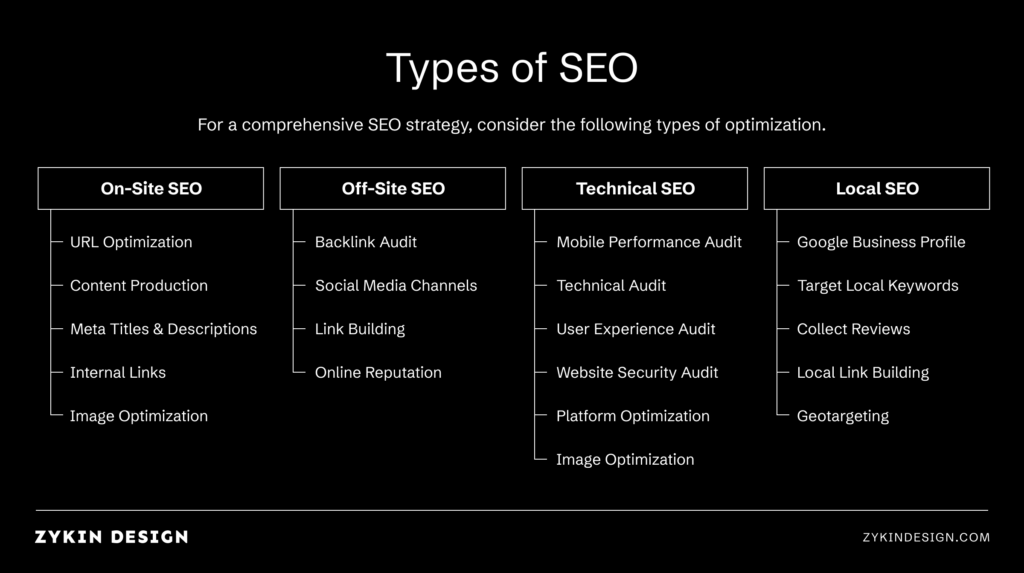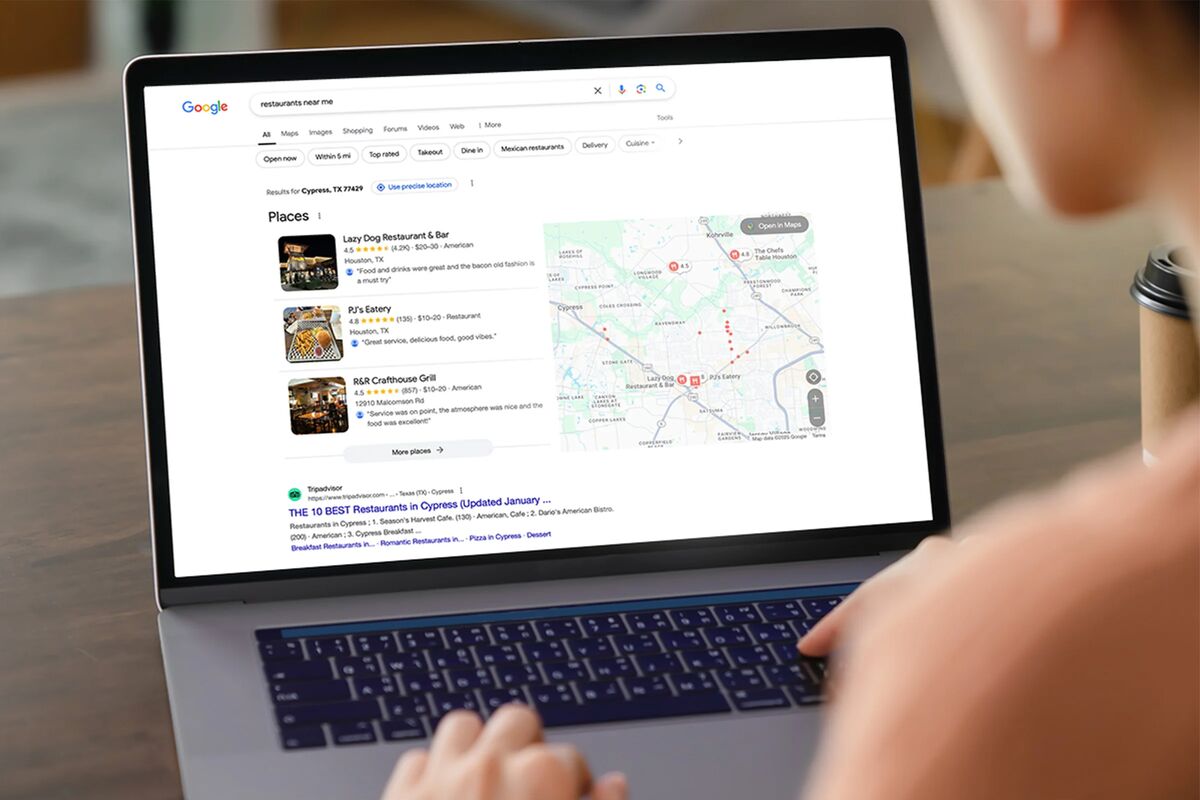
When it comes to improving your website’s visibility and ranking in search engine results, understanding the different types of SEO is crucial. From optimizing your website’s structure and content to building a strong off-site presence, each type of SEO plays a unique role in driving organic traffic to your site. In this article, we’ll explore the key types of SEO—technical, on-site, off-site, and local SEO—breaking down what they entail and how they contribute to your overall digital marketing strategy. Whether you’re new to SEO or looking to refine your approach, we will help you navigate the essentials for achieving sustainable online success.

On-Site SEO
On-site SEO involves optimizing the content on your website to improve search engine ratings and attract relevant traffic. When optimizing on-site content, an SEO expert will use the research done during the Action Plan phase to determine who your audience is, what they are looking for, and how to best engage them. This is also where keyword research becomes highly valuable. The aim is to create content that is authoritative, trustworthy, and aligned with user intent. As search engines have become more sophisticated, they can now recognize synonyms and understand context, making it essential to focus on relevance and user intent rather than just keyword placement.
Activities like keyword stuffing (overloading content with keywords to manipulate rankings) can be penalized by search engines, so it’s best to stay away from these kinds of practices. Optimizing areas like title tags, meta descriptions, and page headings with relevant keywords will help search engines understand what your site pages are about so they are indexed appropriately.
Striking the right balance between creating valuable content for users and optimizing for search engines is crucial. Overemphasizing one at the expense of the other can lead to poor results, like search engine penalties or high bounce rates. Creating an effective content strategy that incorporates audience and keyword research, thoughtful design, and well-crafted content is paramount to effective on-site SEO. Below are some examples of on-site SEO implementation:
- Optimizing Title Tags: Craft title tags that are specific, relevant to the content, and naturally incorporate keywords.
- Relevant Meta Descriptions: Write meta descriptions that are concise, include keywords, and provide searchers with the answer they are looking for.
- Keyword Optimization: Include keywords throughout the site’s content without overusing them. Remember, search engines can understand synonyms and context, so well-written, natural copy will always outperform keyword stuffing.
- Internal Linking: Link pages in your website to other relevant pages in your site helps search engines understand your site structure as well as guides users to other content that they weren’t necessarily looking for, but could find helpful.
- High Quality Content: Publish well-researched, original content throughout your website and blog. Focusing on high quality, original content and avoiding templates and stock imagery (unless absolutely necessary) will boost authenticity, user engagement, and ultimately, search engine rankings.
Off-Site SEO
Off-site SEO is optimizing the actions you take outside of your website to increase your visibility in the SERPs. Off-site SEO is all about building strong brand awareness and online presence beyond your own website. High quality, relevant content, and positive reputation help improve your site’s authority and relevance in the eyes of search engines. When people are aware of your brand and know what products or services you have to offer, they are more likely to remember you and then search for your business.
With so many elements affecting where you will rank in the SERPs, it’s important to make sure that your off-site strategy works in conjunction with your technical and on-site efforts. Below are some examples of how off-site efforts can be implemented:
- Social Media: Optimize your social media posts so they are relevant, on-brand, and incorporate keywords and geotagging (if applicable). The goal is to have your social media channels rank in addition to your website, enhancing brand awareness. Consistently posting intentional, engaging content is key.
- Building Backlinks: Acquire backlinks that align with your business and its goals will help improve your brand awareness and reputation. Building backlinks takes time and research, but when done properly, it can be a huge factor in your SERP rankings.
- Reviews & Testimonials: Collect positive reviews on platforms like Google, Facebook, Yelp, and industry-specific expertise sites. Encouraging customers to post their feedback is critical in optimizing your off-site presence and validating your reputation.
- Guest Posting: Writing and publishing articles on other reputable websites in your industry can help you build backlinks, expand your audience, and establish yourself as an authority in your niche. Guest blogging allows you to reach new readers and drive traffic back to your own site.
Technical SEO
Technical SEO is all about making sure that search engines can crawl and index your site effectively, and that it performs well for users. Search engines like Google will send out “crawlers” or “spiders” to explore your website and its pages. The crawlers will collect data about each page, like keywords, links, and metadata. Once the crawler has gathered the necessary information to understand what the page is about, it is added to the search engine’s index, which is essentially a massive database of web pages. This allows the page to be retrieved and displayed in search results when relevant queries are made. In order to do this, your site needs to have a strong foundation and provide a good user experience.
A marketing specialist can conduct a thorough audit of your site, identifying and resolving technical issues that may hinder its performance. Critical factors like core web vitals, mobile-friendliness, site security, and load times play a significant role in determining how well your site ranks in search results. The healthier and better-performing your site is, the more likely it is to be prioritized by search engines. Below are some examples of technical SEO implementation:
- Optimize for Mobile: With most searches now occurring on mobile devices, it’s crucial to perform a mobile site audit. This ensures your site delivers an equally excellent experience on mobile as it does on desktops or laptops.
- Improve Page Speed: Few things are more frustrating than a slow-loading website. When pages take too long to load, users often leave before they even see your content, opting to go elsewhere. By enhancing your site’s speed, you ensure visitors can quickly access what your site has to offer.
- Implement HTTPS: Implementing HTTPS enhances security and protects sensitive customer information. This not only safeguards user data but also provides a slight ranking boost, as search engines favor secure sites. It’s essential to migrate your website’s pages from HTTP to HTTPS and address any mixed content errors that are found. Mixed content errors occur when an HTTPS page includes assets and media that are loaded with an HTTP connection, which can compromise the security of the page.
- Fix Broken Links: A thorough site audit can identify broken links, whether they’re outdated internal links or external links that no longer work. Addressing these issues ensures your site’s navigation and user experience remains seamless and reliable.
- Resolve Crawl Errors: A technical site audit can reveal pages that search engines struggle to crawl. Errors may include DNS errors, server errors, or redirect loops. By fixing these errors and setting up proper redirects, you enhance your site’s crawlability and indexing.
Local SEO
Local SEO is a form of specialized search engine optimization that involves improving a business’s visibility in local search results. This is particularly important for businesses that have a physical location that they want customers to visit, or providers that serve a specific geographic area.
The goal of local SEO is to ensure that your business appears in local search queries, such as “coffee shop near me” or “concrete contractors in [city].” This type of SEO is crucial for businesses that rely on local customers, as it helps them stand out in their community and attract more foot traffic or service inquiries. By optimizing your online presence for local search, you increase the chances of appearing in the “local pack” (the top three results displayed in a box above organic search results) and on Google Maps.
- Google Business Profile Optimization: Your Google Business Profile listing is one of the most important pieces of your online presence, especially if you only serve local customers. Making sure phone numbers, addresses, and links to websites and social media channels are up to date is one of the first things you should consider optimizing.
- Local Listings: Ensuring your business information is consistent across all online directories and industry-specific sites is crucial. These listings help search engines verify the accuracy of your business information and improve your local rankings.
- Localized Content: By creating and posting content tailored to the specific geographic area, you can effectively engage with people who are especially inclined to support local businesses.
Which Approach is Right for You?
One of the greatest advantages of SEO is its data-driven nature. You can regularly measure concrete metrics to determine which efforts are providing the best results. A marketing specialist can analyze this data using tools like Google Search Console and Google Analytics, providing you with regular reports that highlight areas for improvement. Even social media platforms offer metrics to track the performance of your posts, the growth of your follower base, and audience insights.
A marketing specialist can help you assess your current SEO strengths and identify areas where your business could benefit from improvement. It’s important to note that there are no shortcuts or “one-size-fits-all” solutions in SEO, so a well-developed Action Plan is essential before adopting any strategy.
When you’re ready to take the next step, contact us to discuss your goals and how we can help you achieve them.

About the Author
McKell Michaelson is a Digital Marketing Specialist at Zykin Design dedicated to driving business growth, maximizing ROI, and increasing brand visibility through strategic and thorough online marketing campaigns.


